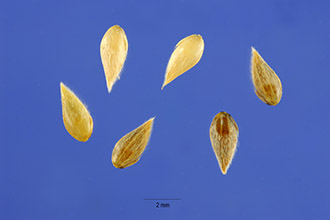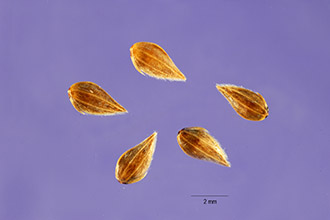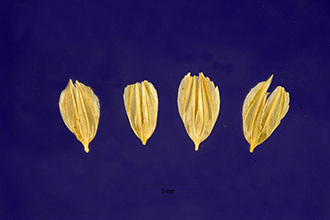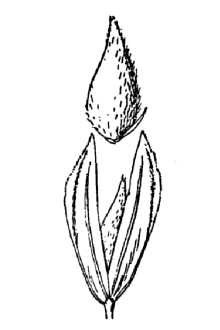Bulbous Canarygrass
Scientific Name: Phalaris aquatica L.

| General Information | |
|---|---|
| Usda Symbol | PHAQ |
| Group | Monocot |
| Life Cycle | Perennial |
| Growth Habits | Graminoid |
| Native Locations | PHAQ |
Plant Guide
Alternative Names
Bulbous canarygrass, hardinggrass, Phalaris tuberosa var, hirtiglumis (koleagrass), Phalaris tuberosa var, Use soil moisture sensors to measure the soil moisture of Bulbous Canarygrass., stenoptera (Harding grass), Towoomba canary grass, alpiste bulbeaux, phalaris tubereux, herbe de Harding, knolliges Glanzgras, capim-doce, rabillode cordero
Uses
Koleagrass was developed for improvement of annual grass range. Its forage production is typically no greater than can be expected from native range. However, this perennial produces forage earlier in the season and stays green longer. Fertilized Koleagrass can extend the green feed period two months or more in the winter compared to unfertilized native grasses, and can add about one month to the green feed period in spring when moisture is not limiting. NOTE: This species has been known to have toxic effects on sheep and cattle. Koleagrass is now considered the standard perennial grass for improvement of annual grass range in California. Please consult the Related Web Sites on the Plant Profile for further information on this species.
Status
Please consult the PLANTS Web site and your State Department of Natural Resources for this plant’s current status (e.g. threatened or endangered species, state noxious status, and wetland indicator values). © Brianna M. Richardson CalPhotos
Weediness
This plant may become weedy or invasive in some regions or habitats and may displace desirable vegetation if not properly managed. Please consult with your local NRCS Field Office, Cooperative Extension Service office, or state natural resource or agriculture department regarding its status and use. Weed information is also available from the PLANTS Web site. Please consult the Related Web Sites on the Plant Profile for this species for further information.
Description
General: Grass Family (Poaceae). Koleagrass is an introduced, tall, robust, rapid-developing bunchgrass with short rhizomes. This species includes both Phalaris tuberosa var. stenoptera (previously known as Harding grass) and Phalaris tuberosa var. hirtiglumis (previously known as koleagrass). P.t. var. hirtiglumis was recognized to have bigger seeds, more vigorous seedlings, yellow-green leaves, and hairy glumes. Both of these varieties have been submerged taxonomically into Phalaris aquatica. Distribution: Koleagrass was introduced from Morocco. Used for pasture and erosion control in California and sparingly in other parts of the southwestern U.S. Consult the PLANTS Web site for its U.S. distribution.
Adaptation
Koleagrass is adapted in California below 2,000 feet to the Mediterranean-like climatic zone or where frost heaving is not a problem. It will grow where there is 12 inches of annual rainfall and there is soil profile development (clay layer). Moisture holding capacity of the soil becomes less critical as rainfall increases. It establishes itself early, grows well during cold winter months, and reseeds readily.
Establishment
Seedbed Preparation: Good stands require a spring-summer fallow to reduce competition from annuals in fall. Fall seeding is done on a firm, weed-free seedbed prepared after the first effective rains (1.5-2.0 inches). This ensures adequate moisture to support seedling growth and destroys the first crop of volunteer annuals. If fallow is prepared before weed species produce seed, the fall weed competition is reduced, but not eliminated. Fall seeding can follow a summer clean-up crop of Sudangrass (Sorghum bicolor ssp. drummondii). Planting is accomplished directly in the Sudangrass stubble. Method of Seeding: Best results are obtained by drilling the seed. Use of a common grain drill is possible if the seed is first mixed with rice hulls as a dilutor and the drill is properly calibrated. If seed is broadcast and covered by harrowing or dragging, the seeding rate is increased 1.5 times. Seeding depth should be ¼-1/2 inch in all cases. Weed Control: During the establishment season, mowing may be necessary to reduce competition from annuals. Set the mower at a height compatible with regrowth of the koleagrass and other perennials. Remove as little leaf area of the koleagrass and other perennials as possible so that development will not be retarded. Fertilization: Do not apply fertilizer in the establishment year. In the second and subsequent years, 200 pounds per acre 16-20-0 (ammonium-phosphate-sulfate) is recommended in the fall.
Management
Koleagrass should not be grazed until completion of growth the first season. At the end of the green feed period, dry forage can be grazed if the plants are large enough to resist pulling by livestock. An average stubble height of three to four inches should be maintained. Established Stands: Koleagrass starts growth in fall coincident with the first rains. Mature stands of koleagrass should be ready for grazing (6-8 inches high) by early January. The amount of growth depends on the amount of rain, its distribution, temperature and soil fertility. Cold tolerance is improved by the inclusion of phosphorus with nitrogen during fall fertilization. Grass can be grazed at range readiness without harm to the plant so long as the ground is firm and not so wet that damage from trampling might occur. Grazing should stop when fertilized annual range is ready for use or when there is a three-inch average stubble height. Grazing will normally end in late February. However, lack of moisture or poor growing conditions may require earlier termination. Infrequently, when abundant rainfall occurs in late winter, grazing can continue through mid-March. Following winter grazing, the perennials, including koleagrass, must be rested to allow recovery and re-growth. This deferment period should continue until the annual range grasses begin to dry up and lose their high feed value. By the time the annual range is dry, koleagrass will have produced seed and stored food reserves in the roots. The leaves will still be green and will remain green for about one month after the annuals are dry. This palatable forage can be grazed heavily until the average stubble height is three inches. When grazing ends, many plants will be heavily used, others partially grazed, and there will be numerous seed stalks left.
Pests and Potential Problems
None
Control
Please contact your local agricultural extension specialist or county weed specialist to learn what works best in your area and how to use it safely. Always read label and safety instructions for each control method. Trade names and control measures appear in this document only to provide specific information. USDA, NRCS does not guarantee or warranty the products and control methods named, and other products may be equally effective.
Seeds and Plant Production
Plant Production
Plant Production
Koleagrass can be grown as an annual for purposes of seed production. At the Lockeford Plant Materials Center, irrigated rows spaced 30 inches apart yield 400-600 pounds per acre of seed when harvested with a binder in late spring following fall seeding. Koleagrass seed averages 267,000 seeds per pound. Cultivars, Improved, and Selected Materials (and area of origin) ‘Perla’ Cultivar- This cultivar was introduced from Morocco. It is easy to establish, grows well during cold winter months, and produces good seed crops. Stands frequently improve through natural reseeding. Also, it’s adapted to soils with restricting layer in Mediterranean climatic zone wherever average annual rainfall is 400mm or more. Contact your local Natural Resources
Conservation
Service (formerly Soil Conservation Service) office for more information. Look in the phone book under ”United States Government.” The Natural Resources Conservation Service will be listed under the subheading “Department of Agriculture.”
Plant Traits
Growth Requirements
| CaCO3 Tolerance | Low |
|---|---|
| Frost Free Days, Minimum | 280 |
| Frost Free Days, Minimum | 240 |
| Fire Tolerance | High |
| Fire Tolerance | High |
| Fertility Requirement | Medium |
| Fertility Requirement | Medium |
| Drought Tolerance | High |
| Drought Tolerance | High |
| Cold Stratification Required | No |
| Cold Stratification Required | No |
| Temperature, Minimum (°F) | 7 |
| CaCO3 Tolerance | Low |
| Anaerobic Tolerance | High |
| Anaerobic Tolerance | High |
| Adapted to Medium Textured Soils | Yes |
| Adapted to Medium Textured Soils | Yes |
| Adapted to Fine Textured Soils | Yes |
| Adapted to Fine Textured Soils | Yes |
| Adapted to Coarse Textured Soils | No |
| Adapted to Coarse Textured Soils | No |
| Hedge Tolerance | None |
| Temperature, Minimum (°F) | 7 |
| Shade Tolerance | Intolerant |
| Shade Tolerance | Intolerant |
| Salinity Tolerance | Medium |
| Salinity Tolerance | Medium |
| Root Depth, Minimum (inches) | 12 |
| Root Depth, Minimum (inches) | 12 |
| Precipitation, Minimum | 18 |
| Precipitation, Minimum | 16 |
| Precipitation, Maximum | 40 |
| Precipitation, Maximum | 40 |
| pH, Minimum | 5.7 |
| pH, Minimum | 5.4 |
| pH, Maximum | 7.5 |
| pH, Maximum | 7.5 |
| Moisture Use | High |
| Moisture Use | High |
| Hedge Tolerance | None |
Morphology/Physiology
| Active Growth Period | Fall, Winter and Spring |
|---|---|
| Toxicity | None |
| Toxicity | None |
| Shape and Orientation | Erect |
| Shape and Orientation | Erect |
| Resprout Ability | No |
| Fall Conspicuous | No |
| Foliage Porosity Winter | Dense |
| Foliage Porosity Summer | Moderate |
| Foliage Porosity Summer | Moderate |
| Foliage Color | Green |
| Foliage Color | Green |
| Flower Conspicuous | No |
| Flower Conspicuous | No |
| Flower Color | Yellow |
| Flower Color | Yellow |
| Fire Resistant | No |
| Fire Resistant | No |
| Nitrogen Fixation | None |
| Fall Conspicuous | No |
| Coppice Potential | No |
| Coppice Potential | No |
| C:N Ratio | Medium |
| C:N Ratio | Low |
| Bloat | None |
| Bloat | None |
| After Harvest Regrowth Rate | Rapid |
| After Harvest Regrowth Rate | Rapid |
| Active Growth Period | Fall, Winter and Spring |
| Resprout Ability | No |
| Foliage Texture | Coarse |
| Nitrogen Fixation | None |
| Low Growing Grass | Yes |
| Low Growing Grass | Yes |
| Lifespan | Long |
| Lifespan | Long |
| Leaf Retention | No |
| Leaf Retention | No |
| Known Allelopath | No |
| Known Allelopath | No |
| Height, Mature (feet) | 6.0 |
| Growth Rate | Rapid |
| Height, Mature (feet) | 4.0 |
| Foliage Porosity Winter | Dense |
| Foliage Texture | Medium |
| Fruit/Seed Color | Black |
| Fruit/Seed Color | Yellow |
| Fruit/Seed Conspicuous | No |
| Fruit/Seed Conspicuous | No |
| Growth Form | Rhizomatous |
| Growth Form | Rhizomatous |
| Growth Rate | Rapid |
Reproduction
| Propagated by Cuttings | No |
|---|---|
| Propagated by Seed | Yes |
| Propagated by Seed | Yes |
| Propagated by Sod | No |
| Propagated by Sod | No |
| Propagated by Sprigs | No |
| Propagated by Sprigs | No |
| Propagated by Tubers | No |
| Propagated by Tubers | No |
| Fruit/Seed Persistence | No |
| Seed per Pound | 340800 |
| Seed per Pound | 340800 |
| Seed Spread Rate | Slow |
| Seed Spread Rate | Slow |
| Seedling Vigor | Low |
| Seedling Vigor | Low |
| Small Grain | No |
| Small Grain | No |
| Vegetative Spread Rate | Moderate |
| Vegetative Spread Rate | Moderate |
| Propagated by Corm | No |
| Propagated by Cuttings | No |
| Bloom Period | Early Spring |
| Bloom Period | Early Spring |
| Commercial Availability | Routinely Available |
| Commercial Availability | Routinely Available |
| Fruit/Seed Abundance | Medium |
| Fruit/Seed Abundance | Medium |
| Fruit/Seed Period Begin | Spring |
| Fruit/Seed Period Begin | Spring |
| Fruit/Seed Period End | Spring |
| Fruit/Seed Persistence | No |
| Propagated by Bare Root | No |
| Propagated by Bare Root | No |
| Propagated by Bulb | No |
| Propagated by Bulb | No |
| Propagated by Container | No |
| Propagated by Container | No |
| Propagated by Corm | No |
| Fruit/Seed Period End | Spring |
Suitability/Use
| Palatable Browse Animal | High |
|---|---|
| Palatable Graze Animal | High |
| Palatable Graze Animal | High |
| Palatable Human | No |
| Palatable Human | No |
| Post Product | No |
| Post Product | No |
| Protein Potential | High |
| Protein Potential | Medium |
| Pulpwood Product | No |
| Pulpwood Product | No |
| Veneer Product | No |
| Veneer Product | No |
| Palatable Browse Animal | High |
| Nursery Stock Product | No |
| Nursery Stock Product | No |
| Naval Store Product | No |
| Naval Store Product | No |
| Lumber Product | No |
| Lumber Product | No |
| Fodder Product | Yes |
| Fodder Product | Yes |
| Christmas Tree Product | No |
| Christmas Tree Product | No |
| Berry/Nut/Seed Product | No |
| Berry/Nut/Seed Product | No |



